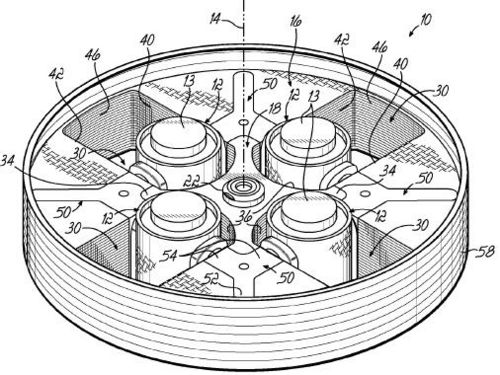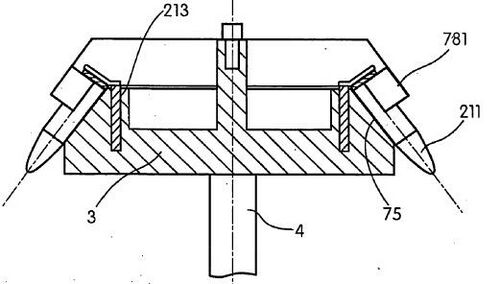Centrifuge: Difference between revisions
imported>Mark Widmer (→RCF: “Relative Centrifugal Force” or g’s: Added note on converting from RPM to rad/s, & new formula in terms of RPM) |
imported>Mark Widmer |
||
| Line 57: | Line 57: | ||
Where: r – radius of the centrifuge (cm), ω – angular velocity (rad/s), g – gravitational constant (cm/s<sup>2</sup>) | Where: r – radius of the centrifuge (cm), ω – angular velocity (rad/s), g – gravitational constant (cm/s<sup>2</sup>) | ||
Note: To convert an RPM value to <math>\omega</math>, multiply the RPM value by 0.105. For example, 1000 RPM becomes 1000 x 0.105 rad/s which is 105 rad/s. In terms of RPMs, the above formula is equivalently written as | Note: To convert an RPM value to <math>\omega</math>, multiply the RPM value by 0.105. For example, 1000 RPM becomes 1000 x 0.105 rad/s, which is 105 rad/s. In terms of RPMs, the above formula is equivalently written as | ||
<math>\ RCF = \frac{r \mbox{ } (\mbox{RPM } \times 0.105)^2}{g} \,</math> | <math>\ RCF = \frac{r \mbox{ } (\mbox{RPM } \times 0.105)^2}{g} \,</math> | ||
Revision as of 15:00, 2 October 2021
For the course duration, the article is closed to outside editing. Of course you can always leave comments on the discussion page. The anticipated date of course completion is 21 December 2010. One month after that date at the latest, this notice shall be removed. Besides, many other Citizendium articles welcome your collaboration! Note to course participants: Looking forward to some insightful and useful articles from your collaborations. |
Centrifuge - A device which separates particles or droplets suspended in a liquid based on their relative densities,using centrifugal force generated by spinning the sample rapidly around a fixed axis. The device decreases the sedimentation time of these particles through the use of centripetal acceleration.
Types of centrifuges
Centrifuges fall into three different categories based on size: laboratory, process-scale, and human-sized. Laboratory centrifuges are the smallest of the three and are primarily used for cell sedimentation and purification. Industrial sized centrifuges are significantly larger than laboratory centrifuges and are utilized for large separation processes. The largest centrifuges are human-sized and are scientifically utilized by space agencies and biomedical research to simulate high gravity conditions.
Laboratory centrifuges
Laboratory Centrifuges are frequently used in various scientific protocols such as DNA and protein purification. The most common laboratory centrifuge is the bench top centrifuge because they are multipurpose and have removable rotors. Laboratory centrifuges can spin up to about 20,000 rpm.
For more information:
Process scale centrifuges
Biological and chemical processing plants use large-scale centrifuges for separation and sedimentation. The two most common separation centrifuges are tubular bowl centrifuges and disk stack centrifuges. Large gas chromatography centrifuges are also used in Uranium purification.
Tubular bowl centrifuge
In the tubular bowl centrifuge fluid enters the bottom of the centrifuge and exits out the top. Particles separated from the centrifuge are collected on the side of the bowl and need to be cleaned after processing. Fortunately, the bowl is usually easy to remove and wash. Another application for the tubular bowl centrifuge is the separation of a light liquid from a heavy liquid because of the density difference.
Disk stack centrifuge
The disk stack centrifuge is fed from the top into a basin and after passing through a series of disks the clarified liquid is removed from the top. Similar to the tubular bowl centrifuge, the dense particles are captured on the side of the centrifuge. Some disk stack centrifuges have solid discharge valves that can clean the sides and prevent buildup.
Human-sized centrifuge
Moving to a larger scale, human-sized centrifuges are used for high gravity training by NASA and entertainment value in carnival rides such as the Gravitron. Human sized centrifuges spin much slower than their smaller counter parts as sedimentation is undesired.[1][2]
Equations governing centrifuges
Sedimentation velocity
- The speed at which a particle falls out of solution in Earth’s gravitational field.
Where: dp - diameter of the particle (cm), ∆ρ – the difference in densities between the particle and the solvent (g/cm3), g – gravitational constant (cm/s2), μ - viscosity of the solvent (g/cm*s)
RCF: “Relative Centrifugal Force” or g’s
- The strength of the centrifugal acceleration in multiples of gravitational acceleration
Where: r – radius of the centrifuge (cm), ω – angular velocity (rad/s), g – gravitational constant (cm/s2)
Note: To convert an RPM value to , multiply the RPM value by 0.105. For example, 1000 RPM becomes 1000 x 0.105 rad/s, which is 105 rad/s. In terms of RPMs, the above formula is equivalently written as
Particle velocity
- The speed at which the particle falls out of solution in the centrifuge
Retention flow rate
- In an process scale centrifuge, the flow rate at which all the particles will sediment out of solution.
Where: V_g - sedimentation velocity (cm/s), ∑ - sigma factor (cm2)
Sigma Factor
- is the operation constant representing the geometry and speed of the centrifuge.
For tubular bowl centrifuge:
Where: L – length of the column (m), ro - outer radius of centrifuge (cm), ri - inner radius of centrifuge (cm), ω – angular velocity (cm*rad/s), g – gravitational constant (m/s2)
For a disk stack centrifuge:
Failed to parse (syntax error): {\displaystyle \Sigma = \frac{2\pi n(r_o^3-r_i^3) ω^2}{(3g \tan(\theta)}}
Where: ω – angular velocity (cm*rad/s), n – number of discs, ro - outer radius of disks (cm), ri - inner radius of disks (cm), θ - angle between disc and vertical (rad), g – gravitational constant (cm/s2)
References
- ↑ NASA's 20G Centrifuge Featured Image: 20 g Centrifuge (from the NASA website)
- ↑ Gravitron










